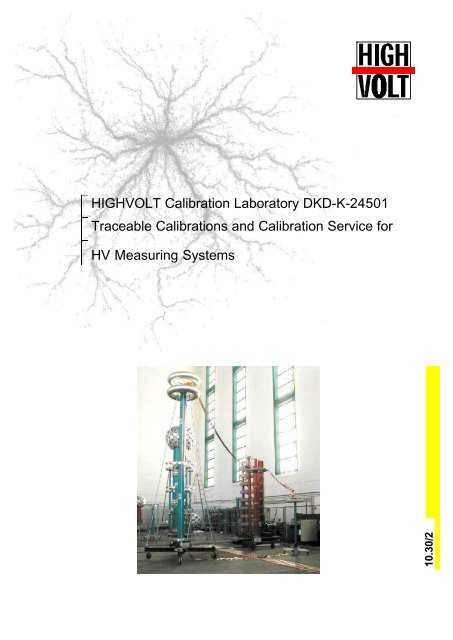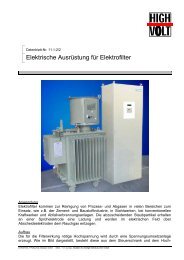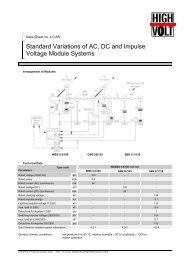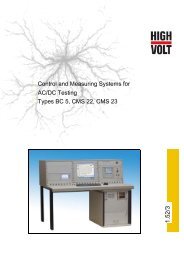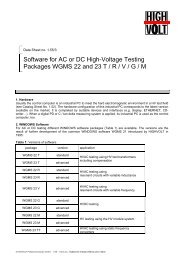HIGHVOLT Calibration Laboratory DKD-K-24501 Traceable ...
HIGHVOLT Calibration Laboratory DKD-K-24501 Traceable ...
HIGHVOLT Calibration Laboratory DKD-K-24501 Traceable ...
Create successful ePaper yourself
Turn your PDF publications into a flip-book with our unique Google optimized e-Paper software.
<strong>HIGHVOLT</strong> <strong>Calibration</strong> <strong>Laboratory</strong> <strong>DKD</strong>-K-<strong>24501</strong><br />
<strong>Traceable</strong> <strong>Calibration</strong>s and <strong>Calibration</strong> Service for<br />
HV Measuring Systems<br />
10.30/2
General Principles and<br />
Requirements for<br />
<strong>Calibration</strong>s<br />
The user of measuring technique, also in<br />
high voltage applications, is confronted with the demand<br />
of technical and quality assurance standards (as the<br />
ISO 9000 series, IEC 60060-2; 1994, IEEE Standard<br />
4.1995) to work with measuring systems calibrated<br />
traceable to National Standards.<br />
The term traceability means a process<br />
whereby the indication of a measuring system (MS) or<br />
instrument (I) can be compared, in one ore more<br />
stages, with a National Standard for the measurand in<br />
question. In each of these stages a calibration has been<br />
performed using a standard with a metrological quality<br />
already determined by calibration with a higher level<br />
standard. The related calibration hierarchy, is shown in<br />
figure 1.<br />
The HV test department of a company must<br />
work with a MS of which at least the first calibration was<br />
proceeded by an accredited calibration laboratory. If a<br />
company operates a high number of MS, the periodical<br />
recalibration may be solved by an in-house calibration<br />
section which has the necessary Reference Measuring<br />
System (RMS, Working Standard) calibrated by a<br />
National Metrology Institute or an Accredited<br />
<strong>Laboratory</strong>, suitable experienced personal and written<br />
calibration instructions.<br />
<strong>Calibration</strong> hierarchy<br />
Na-<br />
tio<br />
-nal<br />
Stan-<br />
dard<br />
Reference<br />
Standard<br />
Reference<br />
Measuring System<br />
(working standard,<br />
factory standard)<br />
Measuring system<br />
of test equipment<br />
Figure 1: <strong>Calibration</strong> hierarchy<br />
National<br />
Metrology<br />
Institute<br />
Accredited<br />
<strong>Calibration</strong><br />
<strong>Laboratory</strong><br />
In house<br />
<strong>Calibration</strong>l<br />
<strong>Laboratory</strong><br />
HV test field<br />
of the<br />
company<br />
Task<br />
To maintain and to<br />
disseminate the<br />
National Standards<br />
To safeguard the<br />
metrological<br />
infrastructure of a<br />
country<br />
Supervision of<br />
measuring<br />
equipment for inhouse<br />
purposes<br />
Measurements and<br />
tests as part of<br />
quality assurance<br />
measures<br />
Accredited calibration laboratories are<br />
established to safeguard the metrological infrastructure<br />
of a country. They realize most of the routine calibration<br />
work for HV departments of companies and in-house<br />
calibration sections. They operate industrially<br />
manufactured Reference Standards with the best<br />
possible characteristic.<br />
The described calibration hierarchy is<br />
completely established in Germany where<br />
PTB The Physikalisch-Technische Bundesanstalt in<br />
Braunschweig is the German National<br />
Metrological Institute and has the responsibility<br />
for the National Standards of measurement by<br />
law.<br />
<strong>DKD</strong> In the German <strong>Calibration</strong> Service (Deutscher<br />
Kalibrierdienst) calibration laboratories of the<br />
industry and other institutions are jointed. They<br />
are accredited and supervised by the<br />
accreditation body of the German <strong>Calibration</strong><br />
Service (<strong>DKD</strong>) at the PTB according to fixed<br />
criterions, as e.g. the <strong>HIGHVOLT</strong> <strong>Calibration</strong><br />
<strong>Laboratory</strong>.<br />
The <strong>DKD</strong>-laboratories issue <strong>DKD</strong>-<br />
<strong>Calibration</strong> Certificates with a fixed structure. A <strong>DKD</strong>-<br />
<strong>Calibration</strong> Certificate contains detailed information<br />
about the calibration object, the calibration procedure,<br />
measuring conditions, measuring results und<br />
uncertainty of measurement. The <strong>DKD</strong>-Certificate may<br />
contain a conformity declaration concerning IEC 60060-<br />
2 if the conformity was proved by measurements. The<br />
certificates are valid for the moment and for the<br />
conditions of the calibration. The user is obliged to have<br />
the object recalibrated at appropriate intervals.<br />
The German <strong>Calibration</strong> Service is a<br />
signatory to the multilateral agreement of the “European<br />
Co-Operation for Accreditation” (EA) for the mutual<br />
recognition of calibration certificates.<br />
Basis for the<br />
calibration or<br />
measurement<br />
Statutory duty to<br />
represent SI units and<br />
ensure international<br />
compatibility<br />
<strong>Calibration</strong> Certificate<br />
from National Metrology<br />
Institute or an<br />
accredited laboratory<br />
<strong>Calibration</strong> Certificate<br />
from National Metrology<br />
Institute or an<br />
accredited laboratory<br />
<strong>Calibration</strong> certificate<br />
from accredited<br />
laboratory or factory<br />
calibration certificate,<br />
calibration mark<br />
Documentation for<br />
the calibration or<br />
measurement<br />
<strong>Calibration</strong><br />
certificate for<br />
reference<br />
standard<br />
<strong>Calibration</strong> certificate<br />
for working standard<br />
or factory standard<br />
Factory calibration<br />
certificate, calibration<br />
mark or the like<br />
for test equipment<br />
Test mark or the<br />
like
Characteristics of the<br />
<strong>HIGHVOLT</strong> <strong>Calibration</strong><br />
<strong>Laboratory</strong> <strong>DKD</strong>-K-<strong>24501</strong><br />
Table 1 shows the ranges and uncertainties of<br />
measurement published by <strong>DKD</strong> after accreditation of<br />
the laboratory. You also can find this table in<br />
http://www.dkd.info/en/_laboratorien.htm .<br />
Meas.<br />
quantity<br />
Range Conditions<br />
Uncertainty<br />
Comments<br />
DC 1 V up to 1000 V 0.05 % MI 1)<br />
5 kV up to 300 kV acc. to IEC<br />
60060<br />
0.4 % MS, divider 3)<br />
AC 1 V up to 700 V 50 Hz 0.05 % MI 1)<br />
Û√2, Ueff 100 V 10 Hz up to 500<br />
Hz<br />
0.05 % MI 1)<br />
Û√2, Ueff 5 kV up to 125 kV 50 Hz 0.4 % MS, divider 1)<br />
Û√2 5 kV up to 100 kV 30Hz up to<br />
300Hz<br />
0.4 % MS, divider 3)<br />
Û√2, Ueff 10 kV up to 200kV 50 Hz 0.45 % MS, divider 3)<br />
Û√2, Ueff<br />
Impulse<br />
voltage<br />
peak value<br />
100 kV up to 800<br />
kV<br />
50 Hz 0.8 % MS, divider 1)<br />
acc. to<br />
IEC 61083 /<br />
DIN EN 61083<br />
LI 50 V up to 1000 V 0.75 % MI<br />
LIC 50 V up to 750 V Last: 0.95 % MI<br />
SI 50 V up to 1000 V ≥ 1 M Ω, ≤ 50 pF 0.75 % MI<br />
Time<br />
parameters<br />
LI T1<br />
T2<br />
0.84 µs<br />
60 µs<br />
coaxial cable:<br />
length 1.5 m 3 %<br />
3 %<br />
LIC TC 0,5 µs up to 6 µs 3 % MI<br />
SI TP<br />
T2<br />
Impulse<br />
voltage<br />
peak value<br />
250 µs<br />
2500 µs<br />
LI 180 kV up to 200 kV<br />
50 kV up to 700 kV<br />
acc. to<br />
IEC 60060 /<br />
DIN EN 60060<br />
3 %<br />
3 %<br />
5)<br />
5)<br />
0.45 %<br />
0.7 %<br />
MI<br />
MI<br />
MS, divider<br />
MS, divider 2), 3), 4)<br />
LIC 180 kV up to 200 kV 0.8 % MS, divider<br />
SI 180 kV up to 200 kV<br />
50 kV up to 500 kV<br />
Time<br />
parameters<br />
0.45 %<br />
0.8 %<br />
MS, divider<br />
LI T1 0.8 µs up to 1.6 µs<br />
3 % MS, divider<br />
T2 40 µs up to 60 µs<br />
3 %<br />
LIC TC 0.5 µs up to 6 µs 3 % MS, divider<br />
SI TP<br />
T2<br />
200 µs up to 300 µs<br />
1000µs up to 4000<br />
µs<br />
Capacitance 10 pF up to 100 pF up to 10 nF<br />
10kV up to 800kV<br />
50 Hz<br />
3 %<br />
3 %<br />
0.1 %<br />
0.05 %<br />
0.5 %<br />
Loss factor 1⋅10 -5 up to 1⋅10 -3 3⋅x 10 -5<br />
Abbreviations and comments:<br />
MS, divider<br />
Capacitors 1)<br />
LI: full lightning impulse voltage T1: front time T2: tail time<br />
LIC chopped lightning impulse voltage TC: chopping time<br />
SI switching impulse voltage T1: front time T2: tail time<br />
MS measuring system MI measuring instrument<br />
1) <strong>Calibration</strong>s only at the permanently stationed laboratory<br />
2) Used ranged range of the digital recorder minimum 50 %<br />
3) <strong>Calibration</strong>s at the permanently stationed calibration laboratory or on site.<br />
The minimal reachable uncertainties of measurement in the case of on site<br />
calibrations have to be increased by considering the contributions of the<br />
voltage generators depending on their characteristics<br />
4) The declared uncertainties are valid for smooth curves without oscillations<br />
and without overshoot.<br />
5) The declared uncertainties are valid for the means value of minimal 10<br />
measurements.<br />
<strong>Calibration</strong> service at the<br />
<strong>HIGHVOLT</strong> <strong>Calibration</strong><br />
<strong>Laboratory</strong> <strong>DKD</strong>-K-<strong>24501</strong><br />
On the basis of these ranges and the demand<br />
of IEC 60060-2 that MS have to be calibrated at least at<br />
20 % of the maximum voltage applied for quality<br />
relevant tests <strong>HIGHVOLT</strong> supplies the calibration<br />
service for<br />
Measuring Systems<br />
and Dividers up to<br />
� 1500 kV DC<br />
� 1000 kV AC<br />
(on-site)<br />
� 3000 kV AC<br />
(in our<br />
laboratory)<br />
� 3500 kV LI<br />
� 2500 kV SI<br />
and additionally<br />
� Peak voltmeters<br />
� Standard<br />
Capacitors<br />
We perform calibrations in our laboratory in Dresden,<br />
Germany, where we have own voltage generators for<br />
1000 kV AC, 600 kV DC and 800 kV LI/SI, or at the test<br />
laboratory of customers (on-site calibration). Our<br />
equipment is prepared for an on-site calibration service<br />
in Middle Europe.<br />
Of course, all new <strong>HIGHVOLT</strong> Measuring<br />
Systems may get a <strong>DKD</strong>-calibration on request of the<br />
customer.<br />
The use of the service of <strong>DKD</strong>-K-<strong>24501</strong> has<br />
the following advantages for the users of HV test<br />
equipment:<br />
� Competent advice concerning all questions of<br />
service and calibration by our highly qualified and<br />
very experienced staff<br />
� Independent consideration of each calibration<br />
procedure<br />
� Independent consulting in all question concerning<br />
calibration technique and procedures<br />
� Time and cost effective on-site procedures without<br />
risk for the calibration object<br />
� Clear demonstration of the traceability of the<br />
measurement – long discussions with assessors of<br />
accreditation bodies can be avoided<br />
� Optimal relation between prices and performance
How to get a calibration<br />
<strong>Calibration</strong> possibilities<br />
Customer<br />
<strong>Calibration</strong> enquiry<br />
<strong>Calibration</strong> offer<br />
<strong>Calibration</strong> order, confirmed program<br />
Data input into the register<br />
Preparation of the equipment<br />
Transportation<br />
Regulation of the form of the calibration voltage<br />
Figure 3: Procedure of a calibration<br />
Enquiry<br />
A qualified enquiry should be the basis for the choice of<br />
the equipment and estimation of the content of<br />
calibration. The leaflet No. 10.31 including<br />
questionnaire added may be helpful to fix the calibration<br />
task.<br />
<strong>Calibration</strong> offer<br />
After the check of the task under consideration of the<br />
possibilities of the laboratory and the content of<br />
accreditation the customer gets a calibration offer<br />
containing the program of the calibration and all<br />
necessary technical and commercial conditions. In the<br />
case of technically unclear situations the task first will<br />
be discussed with the customer.<br />
For further information please contact:<br />
<strong>HIGHVOLT</strong> Prüftechnik Dresden GmbH<br />
<strong>Calibration</strong> <strong>Laboratory</strong> <strong>DKD</strong>-K-<strong>24501</strong><br />
Marie-Curie-Strasse 10<br />
D-01139 Dresden/ Germany<br />
Telephone : ++49 351 8425 668<br />
Fax : ++49 351 8425 610<br />
e-mail : maucksch@highvolt.de<br />
web-site: www.highvolt.de<br />
Discussion<br />
Confirmation<br />
Arrangement of the measuring circuits<br />
Preparation of the measuring instruments and the computer<br />
Control of the form of the calibration voltage<br />
Proceeding of the measurements<br />
Print of the measuring protocols<br />
Transportation back to <strong>HIGHVOLT</strong><br />
Evaluation of the results, estimation of the uncertainty of measurement<br />
Customer<br />
Internal calibration<br />
<strong>Calibration</strong> certificate<br />
Storage of the measuring data, protocols and certificates<br />
On-site calibrations<br />
In the case of on-site calibrations the customer has to<br />
ensure that the measurements can be proceeded<br />
under sufficient conditions. The following points should<br />
be considered:<br />
• The laboratory should be prepared for the<br />
arrangement of the standards. The necessary<br />
clearances for the standards (given in the offer)<br />
have to be fulfilled.<br />
• The environmental conditions as temperature and<br />
humidity should be inside a range for which the<br />
metrological behaviour of the standard is known<br />
(e.g. temperature +5°C up to 35°C, humidity<br />
between 30 % and 70 %).<br />
• The voltage generators should be in full function<br />
and they have to be operated by the staff of the<br />
customer.<br />
• The test voltage shape should fulfil the limits given<br />
in IEC 60060-1.<br />
or our local representative :
Questionnaire as basis for an calibration offer<br />
Customer<br />
Name of the company:<br />
Address of the company:<br />
Person in charge: Name: Phone:<br />
Measuring System (Please, use one questionnaire for each system)<br />
Kind of voltage:<br />
Rated voltage:<br />
Measuring quantities:<br />
Measuring range:<br />
Are there any measuring taps to be<br />
calibrated?<br />
Divider<br />
Type:<br />
Serial No.:<br />
Rated voltage:<br />
Type of the low voltage part:<br />
Serial no of the low voltage part:<br />
Scale factors:<br />
Measuring instrument<br />
Type:<br />
Serial N.:<br />
Measuring quantities:<br />
Measuring ranges:<br />
No<br />
Fax :<br />
Yes Number Rated voltages:<br />
Measuring range:<br />
Kind of desired calibration On-site At the stationary laboratory<br />
<strong>Calibration</strong> of the measuring system<br />
Divider calibration<br />
<strong>Calibration</strong> of measuring instruments<br />
Desired date<br />
Date and sign of the person in charge<br />
The offiiciiall <strong>DKD</strong> iinformatiion you can fiind iin the worlld wiide web under http://www.dkd.ptb.de/deutsch/kalliillab/pdf/<strong>24501</strong>.pdf<br />
In case of questions and enquiries concerning calibration, please, contact:<br />
<strong>HIGHVOLT</strong> Prüftechnik Dresden GmbH<br />
Kalibrierlaborlabor<br />
Marie-Curie-Str. 10<br />
01139 Dresden<br />
Phone: +49 351 8425 668<br />
Fax: +49 351 8425 9668<br />
e-mail: maucksch@highvolt.de


